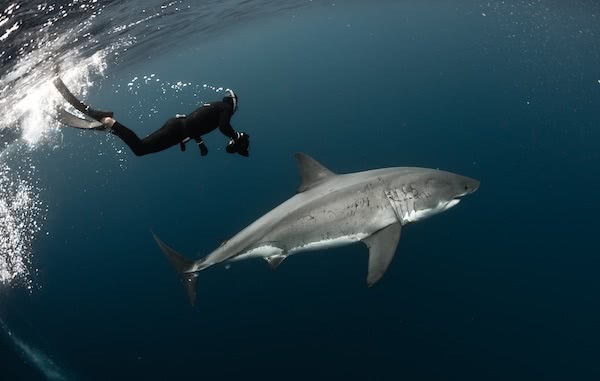Great White Shark 3D is a beautifully shot documentary exploring the fearful and fascinating species at the top of the oceanic food chain. “Our mission”, insists co-director Steve McNicholas, “is to change people’s attitudes toward the Great White … it’s not the menacing, evil predator it’s made out to be”. BRAG spoke to Great White Shark ambassador William Winram about this apex predator and his role in the film.
Forget the famously foreboding music that is probably inadvertently cycling through your brain right now – what unfolds in this film is a thoughtful consideration of what we do and don’t know about these marine creatures. Great White Shark 3D was shot over three years using a high-speed and high-resolution digital camera. The team travelled to multiple Great White hotspots: Guadalupe Island in Mexico, Stewart Island south of New Zealand, the Californian coast and South Africa – where they captured the Great White breaching for the first time in 3D.
Winram and his friend and colleague Fred Buyle were approached by the film’s co-director Luke Cresswell after he saw a video of themswimming with sharks without a cage at the London Dive Show. Though filming had already finished, Cresswell resolved that these men could further the film’s message by reiterating that Great Whites are not monsters. Combining his expert knowledge of shark behaviour and his record-breaking world champion talent as a freediver, Winram tags, films and even takes tissue samples of sharks – all whilst holding his breath (which he can do for eight minutes!). “The only issues we’ve ever had with Great Whites were due to mistakes made, usually by members of the crew,” says Winram. “[Sharks are] highly sensitive to small amounts of blood, to motion in the water, to electrical fields,” he continues. But there remains the need to be cautious of course – freedivers never swim alone and are constantly vigilant. According to Winram, sharks are misunderstood by the general public and unfairly represented in the media: “What really catalysed this terror was the film Jaws and from there it continued to snowball with programming like The Discovery Channel’s Shark Week.”
The moral of the story is: despite how much we fear Great Whites, it’s really us humans who pose the greater danger to them. Executive Director of WildAid, Peter Knights, notes, “over one-third of all open ocean shark species are endangered and up to 73 million sharks are killed by fisherman every year to make shark fin soup.” And there’s still a lot about Great Whites that remains unknown. “We don’t know a lot about the breeding, we don’t know where they give birth, [but] we know more and more about their hunting patterns,” says Winram. “They’re a difficult animal to study, but we’ve learnt a lot by freediving, sitting at the bottom and watching them swim around with sea lions and tuna fish to see how they interact.”
With ethereal footage of the sea, incredible action shots and narration by the British actor Bill Nighy, this documentary will both mesmerise and educate. “If the Great Whites were as they are portrayed in Jaws or in Shark Week, I wouldn’t be able to do what I do,” says Winram.
Great white Shark 3D opens at IMAX Darling Harbour on Thursday January 9.


































